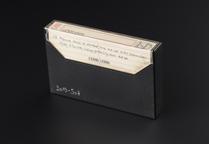

Oral history interview with Ken Burrage, conducted and recorded by Frank Paterson at the Institution of Railway Signal Engineers, London on 23 January 2019. Duration: 1 hr. 49 min. 16 sec. Attitude towards signalling post-Clapham; importance of communications network; British Rail Telecommunications (BRT) set-up; support for concept; fibre optic network maintenance concerns; BRT sale; Network Rail recreation of network; ownership of maintenance of assets critical; contract supervision; internal maintenance brought back; Westinghouse purchase of Design Offices; comparisons pre and post privatisation; positive inputs from contractors; Network Rail reintroduced training; Clapham accident impacts; signalling fault responsible; personal involvement on day of accident; Joint Inquiry; 25 recommendations; hidden Inquiry; 97 recommendations; resistance to change removed; reorganisation; Director Engineering Standards Director 1992-1994; Controller Railtrack Group Standards; move to Westinghouse; relationships with key people; Network Rail; Institution of Railway Signal Engineers (IRSE); competency licensing
One of over 150 oral history recordings made as part of the Britain’s Railways All Change (BRAC) archive project. BRAC was set-up to cover gaps in documenting the railway privatisation process in the United Kingdom, between 1994 and 1997, when the government-owned British Rail was dismantled into over 100 privately-owned companies. The interviews capture the recollections of people involved in the planning and implementation of the privatisation process, the management of change and running the railway during privatisation.
Details
- Category:
- Oral Histories
- Collection:
- Britain's Railways All Change
- Object Number:
- 2020-265
- type:
- oral history interview
- copyright:
- Science Museum Group
- credit:
- Britain’s Railways All Change (BRAC) oral history archive, created in partnership with the Friends of the National Railway Museum, the Retired Railway Officers’ Society and the National Railway Museum.